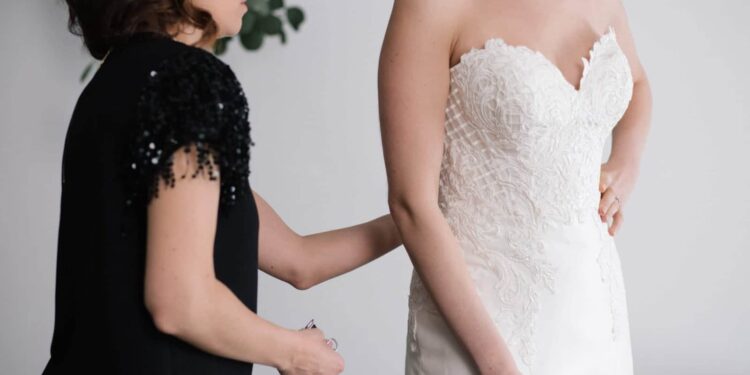
Bridal gown sizing often presents a puzzle, especially for those unfamiliar with how it differs from regular clothing sizes. Navigating this can be perplexing, but understanding the logic behind bridal sizing can simplify the process. Traditionally, bridal sizing has roots in European standards, which tend to run smaller than contemporary U.S. sizes. Despite changes in ready-to-wear sizing, bridal dimensions have largely maintained these historic measurements. This means that your usual size may feel tighter in a wedding dress. Remember, the number is just a guide; the fit truly matters.
Bridal vs. Street Sizing: Understanding the Difference
When it comes to wedding dresses, expect the unexpected in sizing. Bridal gowns generally fit smaller than your regular clothing. This discrepancy is why bridal sizes often appear larger numerically. Moreover, alterations play a vital role in bridal wear, unlike everyday apparel. It’s commonplace for a bridal stylist to suggest a size up for precise adjustments, ensuring the gown fits flawlessly for your big day.
Essential Tips for Measuring Yourself for a Wedding Gown
Many designers provide online size charts, enabling you to pre-measure and have an idea of your size before the fitting. Key measurements include the bust, waist, and hips. Measure the fullest part of your bust, the narrowest part of your waist, and the widest part of your hips. If you fall between sizes, opt for the larger one, as it’s easier to tailor a bigger dress. Having someone assist you with measuring ensures accuracy. However, professional guidance at your bridal appointment is invaluable for the best fit.
How Savvy Bridal Transforms Bridal Sizing into Perfect Fits
Savvy Bridal prioritizes finding a gown that accentuates your beauty, not just a number on a label. Our personalized approach means we cater to every body type, guiding you to the ideal style and fit. Our Kansas City bridal stylists are experts in precise measurements and alterations, ensuring your dress fits beautifully and enhances your confidence on your wedding day.
Comparative Table: Bridal vs. Street Sizing
| Aspect | Bridal Sizing | Street Sizing |
|---|---|---|
| Size Origin | Based on traditional European standards | Modern U.S. sizing standards |
| Measurement Approach | Professional fitting recommended | Standardized, off-the-rack sizing |
| Alteration Expectations | Alterations often necessary for a perfect fit | Rarely altered, ready to wear |
| Sizing Guidance | Usually one to two sizes up recommended | True to size or varies by brand |
Key Points on Bridal Sizing
- Expect a Difference: Bridal sizes tend to be numerically higher than your regular clothing sizes;
- Professional Fittings Matter: Seek expert advice for the most accurate sizing;
- Alterations Are Common: Most wedding gowns require some form of tailoring for a perfect fit;
- Size Is Just a Number: Focus on how the gown feels and fits, rather than the size label;
- Measure Accurately: Use a soft measuring tape and get assistance for precise measurements.
Tailoring to Perfection: The Art of Altering a Wedding Dress”
In the journey of bridal gown selection, understanding sizing is just the beginning. The art of altering a wedding dress plays a pivotal role in achieving the dream look for your special day. This section focuses on the significance and process of dress alterations.
- The Importance of Alterations: Even with the most accurate sizing, alterations are often necessary to tailor a gown to your unique body shape. It’s about perfecting the fit, ensuring comfort, and adding personal touches;
- The Alteration Process: Typically involving a series of fittings, alterations can range from minor adjustments to significant modifications. This could include resizing the dress, adjusting the hem, or adding bespoke elements like lace or beading;
- Working with Professionals: Collaborating with skilled seamstresses or tailors is crucial. They bring expertise in handling delicate fabrics and intricate dress designs, ensuring that your gown is not only a perfect fit but also maintains its original beauty and style;
- Timing and Budgeting: Start the alteration process well in advance of your wedding date. Keep in mind that complex alterations may require more time and budget, so plan accordingly.
Conclusion
As we conclude our exploration of bridal sizing and dress alterations, it’s clear that finding the perfect wedding dress is a multifaceted journey. From understanding the nuances of bridal versus street sizing to navigating the meticulous process of alterations, each step is crucial in shaping your bridal attire. Remember, the number on the size label is just a starting point. The true essence of bridal gown perfection lies in how it’s tailored to accentuate your unique beauty and how it resonates with your style. With the right approach to sizing and alterations, your wedding dress will not only fit impeccably but also embody the elegance and joy of your special day.
